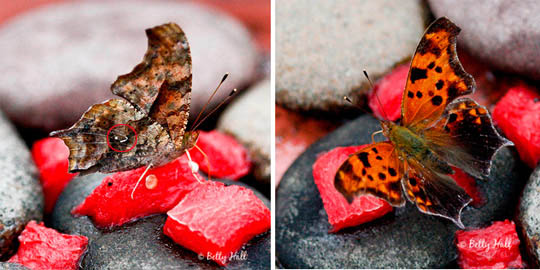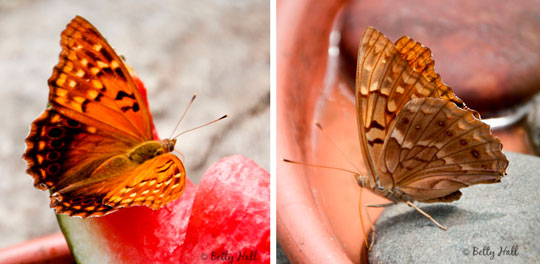I’m not seeing as many butterflies this year, so I decided to put out some watermelon to see what it would attract. Sure enough, I had three different visitors.
If you look closely at the small white markings on the underside of the wings of this Question Mark butterfly (Polygonia interrogationis), you can see where it gets its name. You may need to use your imagination! I’ve never seen this butterfly nectaring on flowers, but I have attracted it with over-ripe fruit before.
Seeing this Tawny Emperor (Asterocampa clyton) was a special treat. I saw one in the backyard for the first time last year, and this is the first I’ve seen this year.
The silhouette of the American Snout (Libytheana carinenta) makes it easy to identify, and makes its name rather obvious. What looks like a “snout” is actually elongated mouth parts (or “palps”).
The caterpillars of all three butterflies feed on Hackberry trees (Celtis occidentalis). We don’t have any Hackberries in our yard, so I’m glad our neighbors do.
I’ve heard other people say they have seen fewer butterflies than usual around Lexington this year. I’m curious what you’re seeing.





Much fewer sadly even w/ our many host plants here in Indianapolis. We did see our first swallowtail yesterday feeding on the purple cone flowers.
Ellen, I keep reminding myself that I saw the most butterflies last year in September and that there is still plenty of time. Maybe the swallowtail is a good omen?
Beautiful! I went to the Arboretum to chase butterflies and only saw one butterfly in more than an hour. =/ I did have a monarch on my new milkweed plant. We were very excited to see that!
Thanks, Regina. Hurrah for the Monarch! However, only one at the Arboretum doesn’t sound too encouraging.
Hi Betty, I bought ‘The Sound of a Wild Snail Eating’ when I saw your comment about it on one of your blogs and am enjoying it. It reminded me of an essay I once wrote on moss when I went back to college. It wasn’t nearly as interesting as i thought it was but it was fun to reread it nonetheless!
Keli, hope you enjoy ‘Wild Snail Eating’ as much as I did. It’s on my list to reread. An essay on moss? I’d like to read it! The word alone recalls special memories for me.
I just sent you email today asking if you’d seen fewer butterflies. I just checked and last year I took a lot of pictures of spicebush swallowtail caterpillars on July 19 and 20, so that was probably when I first looked for them, so I’ll keep checking.
Eve, I’m certainly not seeing as many butterflies as last year and that’s what I’m hearing from others as well. I’m thinking our cold, wet spring could have something to do with that. I’ve only had one Spicebush caterpillar so far. Have seen a few Monarchs. I had a Tiger Swallowtail nectaring on Purple Coneflowers today. Here’s hoping we see more as we move into late summer and fall.
I’ve finally seen an Eastern Swallowtail and Spicebush Swallowtail on our Bottlebrush Buckeye – it’s handy that it is right next to the driveway, so we see them as we come and go!
Eve, I’m assuming by Eastern, you are referring to Eastern Tiger Swallowtail? I saw one on my Tropical Milkweed this morning but no Spicebush in sight. Yes, it does help to have the plants in a place where you see the butterflies often. Thanks for the info. Good to know we do have some butterflies around, even if not as many as last year.